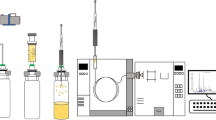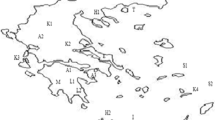Abstract
The current research study focused on the investigation of honeydew honey volatile profile during storage at in-house conditions. The determination of volatile compounds was carried out using headspace solid phase microextraction coupled to gas chromatography/mass spectrometry (HS-SPME/GC–MS). The experiment lasted 53 weeks during which significant variations in the composition of specific alcohols, aldehydes, benzene derivatives, esters, hydrocarbons, ketones, and terpenoids were observed using one-way analysis of variance (ANOVA). In this context, the data obtained were further treated statistically with factor analysis and Bayesian Repeated AVOVA to establish models that could unveil the fluctuations in honeydew honey headspace volatile compounds during storage. Headspace volatile compounds such as 2-butanone, 2-methylpropanal, ethyl acetate and α-pinene could serve as the key indicators of the fluctuations in honeydew honey volatile composition during storage at in-house conditions. The hypothesis driven in the present study supports previous work in the literature concerning the alteration of the volatile composition of honey during storage at different temperatures or mild temperatures, such as those obtained at in-house conditions, providing thus, additional knowledge on the fluctuations in the volatile composition of honeydew honey under these conditions, reflecting among others, its freshness.







Similar content being viewed by others
References
Montenegro G, Gómez M, Casaubon G, Belancic A, Mujica AM, Peña RC (2009) Analysis of volatile compounds in three unifloral native Chilean honeys. Int J Exp Bot 78:61–65
Jerković J, Mastelić J, Marijanović Z (2006) A variety of volatile compounds as markers in unifloral honey from Dalmatian sage (Salvia officinalis L.). Chem Biodivers 3:1307–1316
Castro-Vázquez L, Díaz-Maroto MC, Pérez-Coello MS (2007) Aroma composition and new chemical markers of Spanish citrus honeys. Food Chem 103(2):601–606
Bianchi F, Careri M, Musci M (2005) Volatile norisoprenoids as markers of botanical origin of Sardinian strawberry-tree (Arbutus unedo L.) honey: characterisation of aroma compounds by dynamic headspace extraction and gas chromatography–mass spectrometry. Food Chem 89(4):527–532
Castro-Vázquez L, Díaz-Maroto MC, González-Viñas MA, Pérez-Coello MS (2009) Differentiation of monofloral citrus, rosemary, eucalyptus, lavender, thyme and heather honeys based on volatile composition and sensory descriptive analysis. Food Chem 112(4):1022–1030
Guyot-Declerck C, Renson S, Bouseta A, Collins S (2002) Floral quality and discrimination of Lavandula stoechas, Lavandula angustifolia, and Lavandula angustifoliaxlatifolia honeys. Food Chem 79:453–459
Karabagias IK, Maia M, Karabournioti S, Gatzias I, Karabagias VK, Badeka AV (2020) Palynological, physicochemical, biochemical and aroma fingerprints of two rare honey types. Eur Food Res Technol 246:1725–1739
Cuevas-Glory LF, Pino JA, Santiago LS et al (2007) A review of volatile analytical methods for determining the botanical origin of honey. Food Chem 103:1032–1043
Escriche I, Visquert M, Juan-Borrás M, Fito P (2009) Influence of simulated industrial thermal treatments on the volatile fractions of different varieties of honey. Food Chem 112(2):329–338
Wootton M, Edwards RA, Faraji-Haremi R, Williams PJ (1978) Effect of accelerated storage conditions on the chemical composition and properties of Australian honeys 3. Changes in volatile components. J Apic Res 17:167–172
Visser FR, Allen JM, Shaw GJ (1988) The effect of heat on the volatile flavour fraction from a unifloral honey. J Agric Res 27:175–181
Kaškonienė V, Venskutonis PR, Čeksterytė V (2008) Composition of volatile compounds of honey of various floral origin and beebread collected in Lithuania. Food Chem 111(4):988–997
Castro-Vázquez L, Díaz-Maroto MC, González-Viňas MA et al (2008) Influence of storage conditions on chemical composition and sensory properties of citrus honey. J Agric Food Chem 56:1999–2006
Moreira RFA, De Maria CAB, Pietroluongo M, Trugo LC (2010) Chemical changes in the volatile fractions of Brazilian honeys during storage under tropical conditions. Food Chem 121:697–704
Castro-Vázquez L, Alañon ME, Gonzalez-Viñas MA, Pérez-Coello MS (2012) Changes in the volatile fractions and sensory properties of heather honey during storage under different temperatures. Eur Food Res Technol 235:185–193
da Silva PM, Gonzaga LV, de Azevedo MS et al (2020) Stability of volatile compounds of honey during prolonged storage. J Food Sci Technol 57:1167–1182
IUPAC (1997) Compendium of chemical terminology, 2nd ed. In: AD McNaught, A. Wilkinson The "Gold Book". Blackwell Scientific Publications, Oxford. Online version (2019) created by S. J. Chalk. ISBN 0-9678550-9-8
Vik PW (2013) Regression, ANOVA, and the general linear model: a statistics primer, 1st Edition. SAGE Publications, Inc. ISBN-13: 978-1412997355
Karabagias ΙΚ, Karabournioti S, Karabagias VK, Badeka AV (2020) Palynological, physico-chemical and bioactivity parameters determination, of a less common Greek honeydew honey: “dryomelo’’. Food Cont 109:106940
Jolliffe IT (2002) Principal Component Analysis. Springer Series in Statistics. Springer, New York
Lee MD, Wagenmakers E-J (2013) Bayesian modeling for cognitive science: a practical course. Cambridge University Press
Castro-Vázquez L, Díaz-Maroto MC, Pérez-Coello MS (2006) Volatile composition and contribution to the aroma of Spanish honeydew honeys. Identification of a new chemical marker. J Agric Food Chem 54:4809–4813
Jánosková N, Vyviurska O, Spánik I (2014) Identification of volatile organic compounds in honeydew honeys using comprehensive gas chromatography. J Food Nutr Res 53(4):353–362
Karabagias IK, Badeka A, Kontominas MG (2020) A decisive strategy for monofloral honey authentication using analysis of volatile compounds and pattern recognition techniques. Microchem J 152:104263
Acknowledgements
The author would like to thank Assoc. Prof. Dr. Anastasia Badeka for providing access to the laboratory of Food Chemistry at the Department of Chemistry at the University of Ioannina.
Funding
This research did not receive any specific grant from funding agencies in the public, commercial, or not-for-profit sectors.
Author information
Authors and Affiliations
Corresponding author
Ethics declarations
Conflict of interest
The author declares that he has no conflict of interest.
Compliance with ethics requirements
This study does not contain any studies with human participants or animals performed by any of the authors.
Additional information
Publisher's Note
Springer Nature remains neutral with regard to jurisdictional claims in published maps and institutional affiliations.
Supplementary Information
Below is the link to the electronic supplementary material.
Rights and permissions
About this article
Cite this article
Karabagias, I.K. Headspace volatile compounds fluctuations in honeydew honey during storage at in-house conditions. Eur Food Res Technol 248, 715–726 (2022). https://doi.org/10.1007/s00217-021-03921-9
Received:
Revised:
Accepted:
Published:
Issue Date:
DOI: https://doi.org/10.1007/s00217-021-03921-9




